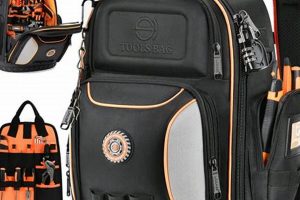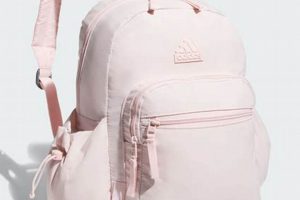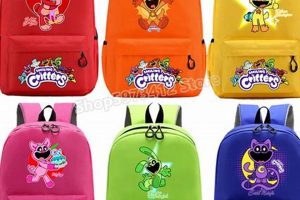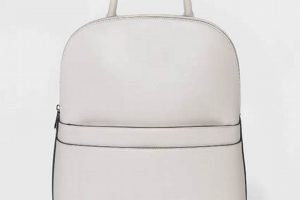The term describes a type of carrying system designed to blend seamlessly into urban environments. It prioritizes inconspicuousness, avoiding overt tactical features and bright colors. A typical example might be a bag constructed from durable, muted-tone fabric, lacking external MOLLE webbing or prominent branding, yet offering practical internal organization.
The importance of such a design lies in its ability to minimize attention, reducing the likelihood of unwanted scrutiny or targeting. This approach is valued for everyday carry purposes, travel, and situations where maintaining a low profile is advantageous. Historically, the concept draws from principles of covert operations and situational awareness, adapting functional utility to civilian contexts.
The following sections will delve into specific attributes that define this particular style of pack, including material selection, organizational features, security considerations, and appropriate use cases. These elements contribute to its overall effectiveness in achieving its intended purpose.
Effective Application Strategies
The following guidelines provide insight into maximizing the utility and discretion of a carrying solution designed for inconspicuous integration into various environments. Careful consideration of these points will enhance its effectiveness.
Tip 1: Prioritize Neutral Aesthetics: Opt for bags devoid of aggressive styling or military-inspired features. Muted colors, such as gray, black, or navy, are preferred. Avoid bright accents or loud logos that draw attention.
Tip 2: Emphasize Internal Organization: Efficient internal compartmentalization allows for rapid access to essential items without unnecessary rummaging. Dedicated pockets for electronics, documents, and small tools contribute to overall efficiency.
Tip 3: Choose Durable, Unassuming Materials: Look for robust fabrics like Cordura or ripstop nylon in non-reflective finishes. Durability is crucial, but the material’s appearance should blend in rather than stand out.
Tip 4: Limit External Attachments: Minimize the use of external pouches or accessories that could compromise the bag’s low profile. If attachments are necessary, select options that match the bag’s color and material.
Tip 5: Practice Situational Awareness: Regularly assess the environment and adjust the bag’s contents and carrying style accordingly. Maintain awareness of surroundings to anticipate potential threats or inconveniences.
Tip 6: Consider Bag Size and Capacity: Select a size appropriate for the intended purpose. A smaller bag is generally less conspicuous, but it must still accommodate essential items. Overpacking can compromise both comfort and discretion.
Tip 7: Maintain Regular Maintenance: Ensure the bag is kept clean and in good repair. A well-maintained bag projects an image of responsibility and reduces the likelihood of attracting unwanted attention due to damage or neglect.
Adherence to these guidelines will optimize the functionality and discretion of such equipment, contributing to enhanced personal security and operational effectiveness in diverse settings. Proper selection and utilization are paramount.
The subsequent sections will examine real-world scenarios and practical applications, further illustrating the benefits of this approach to everyday carry and preparedness.
1. Subdued Coloration
Subdued coloration is a fundamental aspect in the design and utility of equipment intended to blend seamlessly into various environments. This attribute is particularly critical in the context of the “grey man backpack,” where the primary objective is to avoid attracting undue attention and maintain a low profile.
- Minimizing Visual Signature
The principal role of subdued coloration is to reduce the bag’s visual prominence. Colors such as gray, black, navy, and earth tones inherently blend more effectively with urban landscapes and natural settings. For example, a backpack in a neutral gray tone is less likely to stand out in a crowd than one in a bright, saturated color. This reduction in visual signature is crucial for individuals seeking to avoid unwanted scrutiny, whether for security reasons, professional requirements, or personal preference.
- Avoiding Tactical Appearance
Bright or camouflage patterns often associate a bag with tactical or military applications, potentially drawing attention from law enforcement, security personnel, or individuals with malicious intent. Subdued coloration avoids this association, presenting a more civilian and unassuming appearance. A backpack in a solid, muted color conveys a sense of normalcy and blends with the attire of the general population, mitigating the risk of being perceived as a threat or a target.
- Facilitating Versatility Across Environments
Subdued colors enhance the bag’s versatility in diverse environments. A bag designed for urban use may also need to function effectively in rural or suburban settings. Neutral colors are less likely to appear out of place in any of these scenarios, providing a more adaptable and practical solution. For instance, a gray bag can transition seamlessly from a business meeting in the city to a hiking trail in the mountains without attracting unwanted attention in either context.
- Enhancing Concealment Capabilities
For situations where concealment is paramount, subdued coloration becomes an integral element of operational security. By minimizing the visual contrast between the bag and its surroundings, the likelihood of detection is reduced. This principle applies not only to the overall color of the bag but also to the absence of reflective materials or bright accents that could inadvertently reveal its presence. The strategic selection of a color that closely matches the typical lighting and environmental conditions can significantly improve its concealment capabilities.
In summary, the strategic use of subdued coloration in the design of such backpacks is a crucial factor in achieving the desired outcome of blending into the background. By minimizing visual prominence, avoiding tactical associations, facilitating versatility, and enhancing concealment, this attribute contributes significantly to the overall effectiveness of a strategy prioritizing inconspicuousness.
2. Minimal Branding
The deliberate absence of prominent logos or overt branding is a defining characteristic of the “grey man backpack.” This design choice directly correlates with the intent to minimize attention and blend seamlessly into diverse environments. The presence of conspicuous branding negates the core principle of inconspicuousness, rendering the bag more likely to attract unwanted scrutiny. As such, the causal relationship is clear: reduced branding directly contributes to a lower profile.
The importance of minimal branding as a component of this type of pack stems from its practical application in various scenarios. For instance, an individual traveling in a high-crime area might prefer a bag that does not advertise its potential value to would-be thieves. Similarly, professionals operating in sensitive environments might opt for a pack that does not reveal their affiliation or purpose. The strategic reduction of branding is therefore not merely an aesthetic choice but a functional requirement.
In conclusion, minimal branding serves as a crucial element in achieving the desired outcome of blending into the background and avoiding unwanted attention. The effectiveness relies on the principle that a less conspicuous bag is less likely to be targeted or scrutinized, making it a vital consideration for individuals prioritizing security, discretion, and overall situational awareness. Overly branded bags work against this purpose. The connection is direct and essential to the core principle.
3. Durable Materials
The selection of durable materials is paramount in the construction of packs designed for unobtrusive integration into diverse environments. The longevity and reliability of such equipment are directly linked to the quality and resilience of the materials used, ensuring it can withstand the demands of daily use without attracting unnecessary attention due to wear and tear.
- Abrasion Resistance
Abrasion resistance is a critical factor in maintaining a low profile. Materials like Cordura nylon and reinforced canvas are chosen for their ability to withstand friction and prevent visible damage from everyday wear. A bag exhibiting excessive wear and tear is more likely to draw attention, thus compromising its intended purpose. For example, a backpack constructed from ballistic nylon can endure the rigors of urban commuting and outdoor excursions without showing significant signs of abrasion, ensuring its continued inconspicuousness.
- Weather Resistance
Materials with inherent water resistance or those treated with durable water repellent (DWR) coatings are essential for protecting contents from the elements. A water-damaged pack is not only functionally compromised but also visually conspicuous. Fabrics like waxed canvas or ripstop nylon with a waterproof backing provide a barrier against rain and spills, preserving the bag’s appearance and the integrity of its contents. This is vital for maintaining both functionality and discretion in unpredictable weather conditions.
- Tear Strength
High tear strength is crucial for preventing rips and punctures, especially in demanding environments. Materials like ripstop nylon, which incorporates a reinforced grid pattern, are specifically designed to resist tearing. A torn or damaged bag is more likely to draw attention and compromise its ability to blend in. For instance, a pack made from ripstop material can withstand encounters with sharp objects or rough surfaces without developing significant tears, ensuring its continued durability and low profile.
- Seam Construction
While the materials themselves are vital, the manner in which they are joined is equally important. Reinforced stitching, bartacking at stress points, and durable thread contribute to the overall longevity of the bag. Weak or poorly constructed seams are prone to failure, leading to rips and tears that compromise both functionality and appearance. Meticulous seam construction ensures that the bag can withstand heavy loads and repeated use without exhibiting signs of wear or damage, maintaining its inconspicuous profile over time.
The selection of durable materials, coupled with robust construction techniques, ensures the long-term viability of this equipment. The ability to withstand daily wear and tear, resist the elements, and prevent significant damage is essential for maintaining a low profile and achieving the intended purpose of blending seamlessly into various environments. Bags constructed with high-quality, durable materials are an investment in long-term discretion and reliability.
4. Internal Organization
Internal organization serves as a critical, albeit often understated, component of effective carrying solutions designed for inconspicuous integration into varied environments. The correlation between efficient internal organization and the overarching objective of maintaining a low profile is multifaceted. Disorganized contents within a pack necessitate increased search time, potentially drawing attention and negating the advantage of a discreet exterior. In contrast, a well-organized system enables rapid retrieval of essential items, mitigating delays and minimizing exposure.
The importance of structured internal compartments within such a backpack is highlighted in several real-world scenarios. For example, an individual navigating a crowded urban environment might require quick access to identification or a mobile device without attracting unwanted notice. A dedicated, easily accessible pocket for these items streamlines the retrieval process. Similarly, in emergency situations, efficient organization can be the difference between a swift response and a protracted, potentially dangerous delay. A medic, for instance, benefits significantly from clearly labeled and readily accessible medical supplies within their pack.
In conclusion, the practical significance of understanding and prioritizing internal organization in packs designed for unobtrusive use extends beyond mere convenience. It directly contributes to enhanced situational awareness, reduced exposure, and improved response times in various operational contexts. Overlooking this crucial aspect can inadvertently compromise the very purpose of the pack, highlighting the necessity of integrating well-designed internal compartments into the broader strategy of maintaining a discreet and functional carrying system. Any lack of organization would ruin it’s low profile, and create unsafe environments.
5. Low-Profile Design
The concept of low-profile design is central to the utility and effectiveness of a “grey man backpack”. It encompasses a range of features and considerations aimed at minimizing visual signature and avoiding unwanted attention. This approach transcends mere aesthetics, impacting functionality, security, and overall operational effectiveness in diverse environments.
- Absence of Tactical Features
A defining characteristic is the deliberate omission of overtly tactical elements. External MOLLE webbing, excessive straps, and weapon retention systems are avoided. These features, commonly associated with military or law enforcement equipment, attract attention and contradict the goal of blending into civilian environments. A low-profile design prioritizes a streamlined exterior, devoid of features that signal a tactical purpose.
- Streamlined Silhouette
The overall shape and size contribute significantly to its low profile. Bulky, oversized packs are inherently more conspicuous than those with a sleek, streamlined silhouette. A design that conforms closely to the wearer’s body minimizes its visual impact and reduces the likelihood of snagging or catching on obstacles. This is particularly important in crowded urban environments or during periods of movement through confined spaces.
- Inconspicuous Hardware
Even seemingly minor details, such as the type and finish of hardware, can impact overall visibility. Shiny buckles, brightly colored zippers, and reflective materials detract from a low-profile appearance. A design employs muted, matte-finish hardware that blends seamlessly with the fabric and avoids drawing unnecessary attention. Zippers should be concealed or subtly integrated into the pack’s design.
- Concealed Carry Compartments
For individuals requiring the ability to carry a firearm or other defensive tool, a low-profile design incorporates concealed carry compartments that do not compromise the bag’s overall appearance. These compartments are discreetly integrated into the pack’s interior, allowing for rapid access while maintaining a low visual signature. The key is to provide functional utility without advertising the presence of a weapon.
In summary, the pursuit of a low-profile design represents a holistic approach that considers every aspect of the pack, from its overall shape and size to the smallest details of its hardware. This emphasis on inconspicuousness is not merely a stylistic choice but a fundamental requirement for achieving the intended purpose of blending seamlessly into diverse environments and avoiding unwanted attention. This design promotes a sense of normalcy and minimizes the risk of attracting scrutiny or suspicion.
6. Versatile Functionality
Versatile functionality is a cornerstone in the design and selection of a carrying solution intended to blend inconspicuously within a range of environments. This adaptability directly contributes to the equipment’s utility, allowing it to serve multiple purposes without drawing undue attention or compromising its low profile. The ability to transition seamlessly between various roles underscores its value in diverse scenarios.
- Adaptable Compartmentalization
The internal organization of the pack facilitates versatility. Modular compartments, adjustable dividers, and adaptable straps enable customization based on the specific needs of the user. This adaptability allows the bag to function effectively as a daily commuter pack, a travel companion, or even a light-duty emergency kit. For instance, a padded laptop sleeve can be repurposed to secure sensitive equipment, while elastic loops can hold water bottles or medical supplies. This inherent flexibility expands the bag’s utility across a spectrum of applications.
- Convertible Configurations
Some designs offer convertible configurations, allowing the bag to be carried as a backpack, a shoulder bag, or even a briefcase. This adaptability enhances its versatility, enabling the user to adjust the carrying style based on the specific environment and task. A backpack that can be quickly converted into a briefcase offers a more professional appearance in formal settings, while the backpack configuration is ideal for navigating crowded streets or engaging in physical activity. This transformative capability contributes significantly to its overall utility.
- Integration with Accessories
Versatile functionality is further enhanced through compatibility with a range of accessories. Modular pouches, external attachment points, and adaptable straps allow the user to customize the bag’s capacity and organization based on specific requirements. The ability to add or remove accessories provides a flexible solution that can be tailored to various tasks. For example, a first-aid kit can be attached externally for quick access during emergencies, while a water bottle pouch can be added for hydration on the go. This modularity extends its utility across a diverse range of activities.
- Discreet Storage Options
The integration of covert storage compartments also lends to the versatile function. Hidden pockets, false bottoms, or concealed access points enables an user to carry sensitive items without attracting attention. For example, an individual may have the need to carry important documents or a self-defense tool safely. Because of the versatility, it does not compromise the profile of the backpack and gives the user a discreet carrying tool.
The multifaceted nature of versatile functionality ensures it remains adaptable to changing needs and environments. It offers a balance between practicality, discretion, and overall utility, making it an effective choice for individuals prioritizing preparedness and unobtrusive integration in diverse situations. A rigid, specialized bag would fail to meet the needs of many users, however the functionality allows it to go beyond expectations.
7. Comfortable Carry
Comfortable carry is a critical yet often overlooked aspect of bags designed for unobtrusive integration into various environments. While maintaining a low profile and versatile functionality are paramount, the ability to comfortably transport necessary items directly impacts the user’s overall efficiency and operational effectiveness. A bag that is cumbersome or causes discomfort detracts from its intended purpose, potentially drawing attention or hindering the user’s ability to react effectively in dynamic situations.
- Ergonomic Design
Ergonomic design principles dictate the distribution of weight and the contouring of straps and back panels. Padded shoulder straps, sternum straps, and hip belts (where applicable) distribute the load across multiple points, reducing strain on the shoulders and back. A contoured back panel promotes airflow, minimizing heat and moisture buildup. For instance, a bag with S-shaped shoulder straps and a ventilated back panel will provide a more comfortable carry experience compared to a bag with straight straps and a flat back panel, especially during prolonged use or in warm climates.
- Adjustability
Adjustability is crucial for achieving a personalized fit. Adjustable shoulder straps, sternum straps, and hip belts (where applicable) allow the user to fine-tune the bag’s position and weight distribution. The ability to customize the fit ensures that the bag remains stable and comfortable, regardless of the user’s body type or the load being carried. A bag with a wide range of adjustment options will accommodate a broader range of users and carrying styles, contributing to enhanced comfort and usability.
- Breathable Materials
The materials used in the construction of straps and back panels directly impact breathability and comfort. Mesh fabrics and perforated foam promote airflow, reducing heat and moisture buildup. These materials allow for ventilation, minimizing discomfort and preventing the bag from becoming excessively hot or sweaty. For example, a bag with a back panel constructed from air mesh will provide better ventilation compared to a bag with a solid, non-breathable back panel, especially during physical activity or in humid conditions.
- Weight Distribution
Proper weight distribution is essential for maintaining balance and preventing strain. Internal organization features, such as dividers and compression straps, help to stabilize the load and prevent it from shifting during movement. A bag with a well-designed internal structure will distribute the weight evenly across the user’s back, minimizing stress on specific pressure points. This balanced weight distribution contributes to enhanced comfort and reduces the risk of injury, particularly when carrying heavy loads.
Comfortable carry is not merely a matter of personal preference; it is a functional requirement for optimizing performance. A bag that is uncomfortable or poorly designed can hinder movement, increase fatigue, and compromise situational awareness. By prioritizing ergonomic design, adjustability, breathable materials, and proper weight distribution, it ensures that the user can carry necessary items efficiently and comfortably, without drawing unwanted attention or sacrificing operational effectiveness. A comfortable user is a confident and more efficient user.
Frequently Asked Questions
The following questions address common inquiries and misconceptions surrounding this specific type of equipment. The answers provided are intended to offer clear, factual information to assist in making informed decisions.
Question 1: What defines a “grey man backpack” beyond its color?
The defining characteristic extends beyond mere coloration. While subdued colors are common, the key attribute is its capacity to blend seamlessly into diverse environments, avoiding attention. This involves a combination of factors including minimal branding, a low-profile design, durable yet unassuming materials, and versatile functionality that doesn’t overtly signal a tactical or specialized purpose.
Question 2: Is a “grey man backpack” solely for tactical or survivalist purposes?
No. Although the concept shares roots with principles of covert operations, its application extends far beyond tactical or survivalist scenarios. It is suitable for everyday carry (EDC), travel, professional use, and any situation where maintaining a low profile is advantageous. The emphasis is on inconspicuousness and practicality, rather than overt tactical features.
Question 3: How important is internal organization within such a backpack?
Internal organization is paramount. A well-organized interior facilitates rapid access to essential items without unnecessary rummaging, reducing the likelihood of attracting attention. Efficient compartmentalization enhances situational awareness and improves response times in various scenarios, aligning with the core principle of inconspicuousness.
Question 4: What are the primary benefits of utilizing durable materials in its construction?
Durable materials ensure longevity and reliability, withstanding the demands of daily use without attracting attention due to wear and tear. Abrasion resistance, weather resistance, and tear strength are essential factors. A bag exhibiting excessive damage is more likely to draw unwanted scrutiny, thus compromising its intended purpose.
Question 5: Does the absence of external attachments compromise functionality?
Not necessarily. While external attachments can increase carrying capacity, they also detract from the bag’s low-profile design. It prioritizes internal organization and streamlined aesthetics. If external attachments are required, they should be chosen carefully to match the bag’s color and material, minimizing their visual impact.
Question 6: How does comfortable carry contribute to the overall effectiveness?
Comfortable carry is essential for optimizing performance and preventing fatigue. Ergonomic design, adjustable straps, breathable materials, and proper weight distribution ensure that the user can carry necessary items efficiently and comfortably, without hindering movement or drawing attention. A user experiencing discomfort is more likely to exhibit behaviors that attract scrutiny.
In summary, the effectiveness of any such equipment hinges on the comprehensive integration of multiple design elements, all working in concert to achieve a single objective: blending seamlessly into the surrounding environment and minimizing unwanted attention. A holistic approach is required to maximize its utility and maintain a low profile.
The following section will explore real-world case studies, providing practical examples of its application in various contexts.
Grey Man Backpack
The preceding analysis has explored the multifaceted attributes defining the “grey man backpack.” These characteristics, ranging from subdued coloration and minimal branding to durable materials, internal organization, low-profile design, versatile functionality, and comfortable carry, collectively contribute to a carrying solution designed for unobtrusive integration into various environments. The effective application of these principles enhances personal security and operational effectiveness by minimizing attention and facilitating seamless adaptation to diverse scenarios.
The strategic selection and utilization of such a backpack should be viewed as a considered decision, reflecting a commitment to preparedness and situational awareness. As environments evolve and security concerns persist, the principles embodied by the “grey man backpack” remain relevant, emphasizing the importance of discreet practicality in navigating a complex world. Continued vigilance and adaptability are paramount.







